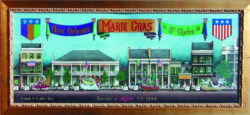Jim Blanchard
Jim Blanchard has created a body of art that records the architectural masterpieces of Louisiana's previous centuries through pieces he calls "architectural archival watercolors."

Courtesy of Jim Blanchard
Mardi Gras Street. Blanchard, Jim (artist)
To New Orleans artist Jim Blanchard, the vernacular and classical architecture of South Louisiana of the eighteenth and nineteenth centuries are grand and eloquent expressions of the human aesthetic; there he finds visual harmony and grace. Throughout his career, Blanchard has created an impressive body of art that records the architectural masterpieces of these previous centuries. His pen-and-ink drawings and paintings done in watercolor and gouache are executed with the precision of an architect’s illustration, yet they are rendered with the elegance of an artist. “I call them architectural archival watercolors,” said Blanchard. “They’re like portraits, not of a person, but of a building. It’s like the house is posing for its portrait. They’re archival because they are three-dimensional and measured scale models of buildings.” He wants them to “serve a purpose,” to have a reason. “I’m creating an image that’s impossible to see anywhere else,” he said.
Blanchard was born in Thibodaux, Louisiana, on October 11, 1955, and grew up along the Bayou Lafourche, surrounded by aging plantations and rural nineteenth-century buildings that survived war, neglect, indifference, and modernization. “South Louisiana architecture has a different flair,” said Blanchard. “After moving to New Orleans in the early eighties, I was overwhelmed with the architecture and history of the city. New Orleans has the largest collection of historic buildings in the country. There’s no other place like it. Probably it was the lack of growth. If we had grown like Atlanta and Houston, we wouldn’t have all that we have.”
Though Blanchard studied art briefly at Nicholls State University in Thibodaux, he is primarily a self-taught artist. He dropped out of Nicholls to join his grandfather, Dave Robichaux, in the family oil brokerage business. There he learned how to conduct research in public archives and church records, and how to make maps for oil companies. After his grandfather’s death in the early 1980s, Blanchard moved to New Orleans, where he returned to his interest in art. Along the way, he met New Orleans historians Ray Samuel, Leonard Huber, and Sally Reeves; art historian and curator H. Parrot Bacot; New Orleans artist Boyd Cruise; and art collector William Groves. Each of them introduced Blanchard to various aspects of Louisiana architecture and repositories that contained eighteenth- and nineteenth-century architectural drawings and plans.
“My pathway and learning experience also came from the past,” Blanchard said. “I studied and admired the works of Louisiana artists such as Marie Adrien Persac, William Buck, Boyd Cruise, Marshall Smith, George Coulon, Joseph Rusling Meeker, and others. I studied the great artists of the past, as well as the artists of the day. … My interest and love for creating my architectural archival drawings took me on a pathway that I had only dreamed of. I began designing and doing renovation designs for friends and clients. This opened up another facet of my art. I am not only drawing two-dimensional images but also designing and building in three dimensions. That part of my career has grown and I have worked on many buildings, such as The Catherine Club, Houmas House Plantation, Bocage Plantation, and the renovations and designs of many historical buildings. … In 1990 Phyllis Hudson [a New Orleans restoration artist], while studying an original Persac in her studio, commented, ‘One day they will be preserving yours just like the Persacs.’ This was one of the highest compliments to ever receive.”
Blanchard’s work can be found in numerous private, corporate, and public collections, including, in New Orleans, the Pickwick Club, Tulane University’s Law Library, the Ogden Museum of Southern Art, The Historic New Orleans Collection, the Poydras Home, the Whitney Bank Collection, and the New Orleans Museum of Art; in Baton Rouge, the Louisiana State University Museum and Old State Capitol Museum; and the River Road plantations Houmas House (where Blanchard lives part time) and Destrehan.
